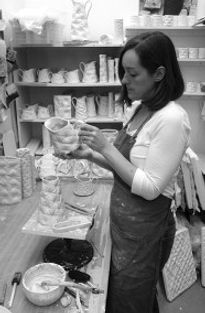S a r a h G r o v e
I have no further events this year but I will update here as soon as 2025 events are booked in.
Both Byard Art in Cambridge and the New Ashgate Gallery in Farnham currently have extensive collections of my work.
Forthcoming Events:
email me at: sarahgroveceramics@gmail.com
New Ashgate Gallery
Handmade in Britain Online
Byard Art - Cambridge
Bircham Gallery - Holt, Norfolk
Lingwood Samuel - Godalming Surrey
Fitch and Fellows - Thame, Oxfordshire
Simon Drew Gallery - Dartmouth
How it's made
My work starts its journey with a piece of textile. I hand sew patchwork, or applique, quilt or embroider in a wide range of interesting fabric textures and machine embroider motifs such as birds, shells and bees.
These textiles are then covered with plaster, which when set, I can peel the fabric away leaving me with a plaster ‘negative’ of the fabric. I now roll out a slab of porcelain, large, flat and smooth. Having worked out paper templates of a jug or vase, I lay the paper over the clay and roughly cut out the shapes needed to be joined together to make an item. Each piece is then pressed firmly against the plaster. All of the detail of the original fabric is translated onto the clay, which can then be peeled off the plaster. My paper pattern templates are then cut around more precisely and the piece I am aiming for can be constructed. Great care has to be taken not to loose textile detail or leave fingerprints and to match the textile joins where a spout meets a jug body. Details are added by sprigging, such as buttons as feet on the base or braid on a handle. The work is dried and biscuit fired, ready to be glazed or in the case of the machine embroidered work, ready to be painted with cobalt. I use a very fine brush, charge it with cobalt and carefully paint over the stitches and only over the stitches! Cobalt is a very strong oxide when fired but remarkably hard to see in its subtlety when raw and can be picked up on a finger to be spread across any other piece handled, only to be noticed after the next firing!
Once out of their second, high temperature glaze firing the plain white but highly textured pieces, have highlights added to catch the light and give interest in the form of opal, mother-of-pearl or more recently, gold lustre. These tiny additions are painted and then into the kiln the pieces go again. I hope you like the finished items and see just how much work and how many processes are involved.
Current Stockists
